Our trip to Rio did not get off to the best of starts. Some idiot failed to set the alarm properly and we were rudely awoken by a call from reception informing us that the taxi was waiting. The idiot had set his mobile to ring at the pick up time and he was duly castigated. Anyway, we were up, washed, dressed, packed up and in the back of the taxi in 12 minutes. The next time Debbie tells me she needs 30 minutes to get ready I will be able to remind her that empirical evidence suggests that she only requires 10.
 I have wanted to be in Rio de Janeiro for the Carnival since my early 20s so I am really excited to be here. I should probably have started saving up for this visit from that delicate age because everything gets a zero added to the price during carnival week and I’m sure that there is a competition among the locals to see who can empty the most cash from the tourist wallet. Fortunately, we had paid for the big ticket items long before we arrived (because payment is demanded in full on booking) so it did not feel quite as expensive.
I have wanted to be in Rio de Janeiro for the Carnival since my early 20s so I am really excited to be here. I should probably have started saving up for this visit from that delicate age because everything gets a zero added to the price during carnival week and I’m sure that there is a competition among the locals to see who can empty the most cash from the tourist wallet. Fortunately, we had paid for the big ticket items long before we arrived (because payment is demanded in full on booking) so it did not feel quite as expensive.
 Rio de Janeiro is one of the great cities of South America. According to the locals, God made the world in six days: the seventh he devoted to Rio. It has a gloriously theatrical backdrop of tumbling wooded mountains, stark expanses of bare rock, and a deep blue sea studded with rocky islands. From the statue of Christ the Redeemer set high on the hunchbacked peak of Corcovado or from the conical peak of Pao de Acucar (Sugar Loaf Mountain), we can experience the beauty of a bird’s eye view of this wonderful city of 10 million inhabitants. Rio has a fine artistic and cultural heritage from its time as a colonial city that became the capital of both Imperial and Republican Brazil. Nowadays it feels as if it is a city dedicated to leisure: sport, music and, during carnival, partying rule.
Rio de Janeiro is one of the great cities of South America. According to the locals, God made the world in six days: the seventh he devoted to Rio. It has a gloriously theatrical backdrop of tumbling wooded mountains, stark expanses of bare rock, and a deep blue sea studded with rocky islands. From the statue of Christ the Redeemer set high on the hunchbacked peak of Corcovado or from the conical peak of Pao de Acucar (Sugar Loaf Mountain), we can experience the beauty of a bird’s eye view of this wonderful city of 10 million inhabitants. Rio has a fine artistic and cultural heritage from its time as a colonial city that became the capital of both Imperial and Republican Brazil. Nowadays it feels as if it is a city dedicated to leisure: sport, music and, during carnival, partying rule.
The city was first ‘discovered’ by Portuguese navigator, Goncalo Coelho, who arrived on 1st January 1502. Thinking it was the mouth of a great river, he called the place January River (Rio de Janeiro). However, the Portuguese did not use the enormous bay as a port and it was first settled by the French who stayed until 1567 when the Portuguese eventually threw them out by force. By the 18th Century, Rio became the leading city in Brazil – not only was it the port from which gold was shipped back to Europe, it was also the focus of the import/export trade of the surrounding agricultural land. In 1834 it became the capital, taking over from San Salvador, until this honour was transferred to Brasilia 125 years later.
 With such a fantastic setting, it does not feel like an enormous city and it is broken into distinct parts. We stayed in an area called Leblon, two beaches away from the famous but now hopelessly touristy Copacabana. Our end was a bit quieter and, apparently, safer but there is still a 24 hour buzz about the place and it is difficult to find much space on the beach. I cannot remember the last time I felt so crowded by the sea as, from 11 o clock, more and more people arrive to stake a spot in the sand. However, I was not concerned: in my dreams I was expecting beautiful girls wall to wall, clad in g-strings and eye patches. The reality, as so often, was somewhat different. There were hundreds of girls (and boys – Debbie tells me), wearing bathing suits made from the minimum of material, as if clothing was the most expensive commodity on earth, but they were not all drop dead gorgeous.
With such a fantastic setting, it does not feel like an enormous city and it is broken into distinct parts. We stayed in an area called Leblon, two beaches away from the famous but now hopelessly touristy Copacabana. Our end was a bit quieter and, apparently, safer but there is still a 24 hour buzz about the place and it is difficult to find much space on the beach. I cannot remember the last time I felt so crowded by the sea as, from 11 o clock, more and more people arrive to stake a spot in the sand. However, I was not concerned: in my dreams I was expecting beautiful girls wall to wall, clad in g-strings and eye patches. The reality, as so often, was somewhat different. There were hundreds of girls (and boys – Debbie tells me), wearing bathing suits made from the minimum of material, as if clothing was the most expensive commodity on earth, but they were not all drop dead gorgeous.
The boys back home were expecting me to send back photographs of the ‘best sites’ but how can I go about fulfilling such orders without appearing to be a complete pervert? The trusty long range lens was no use because people were too closely packed together. The solution was to get hold of a bib that said ‘PRESS’ very loudly but, rather unsportingly I thought, every press person I asked told me to get lost. So, I have to apologise to our Sun newspaper readers (i.e. those that only look at the pictures) for lack of images of the local talent.
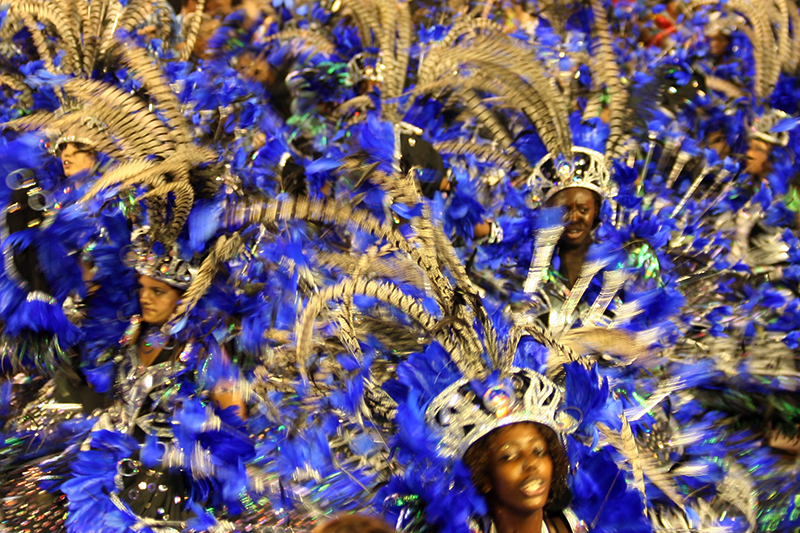 However, the great carnival parade provided plenty of opportunity to snap as much flesh as the camera’s digital memory card would allow. What a spectacle! A highly organized riot of colour, dancing, singing and joy that goes on all night long finishing as dawn throws long shadows across the city.
However, the great carnival parade provided plenty of opportunity to snap as much flesh as the camera’s digital memory card would allow. What a spectacle! A highly organized riot of colour, dancing, singing and joy that goes on all night long finishing as dawn throws long shadows across the city.
It all begins on the Friday before Shrove Tuesday when the Mayor of Rio hands over the keys to the City to Rei Momo, the Lord of Misrule, signifying the start of the five day party. Imagination runs riot, social barriers are broken down and the main avenues, full of people and children wearing fancy dress, are colourfully lit. Large areas are turned over for shows, music and dancing. Bandas and Blocos (local organized carnival groups) seem to be everywhere dancing, drumming and singing.
 The centerpiece is the nightly carnival parade that passes through the Sambodromo, a purpose-built stadium that holds 60,000 people with a parade runway 700 metres long. The top 24 samba schools each put on a parade and get marked by the 40 judges dotted along the runway as they compete for the honour of being marked the top school. They even have two divisions of twelve complete with promotion and relegation. And, of course, the judges also decide who is going to be named Carnival Queen. The results are announced on Ash Wednesday and the top six ranked schools get to parade again the following Saturday. It’s a serious business for the schools because the takings from the stadium tickets are divided up, after the organizers take their cut, according to their ranking. And the takings are considerable; the cheapest price for a single ticket is US$5 (if you are a local) rising very quickly up to US$1,400.
The centerpiece is the nightly carnival parade that passes through the Sambodromo, a purpose-built stadium that holds 60,000 people with a parade runway 700 metres long. The top 24 samba schools each put on a parade and get marked by the 40 judges dotted along the runway as they compete for the honour of being marked the top school. They even have two divisions of twelve complete with promotion and relegation. And, of course, the judges also decide who is going to be named Carnival Queen. The results are announced on Ash Wednesday and the top six ranked schools get to parade again the following Saturday. It’s a serious business for the schools because the takings from the stadium tickets are divided up, after the organizers take their cut, according to their ranking. And the takings are considerable; the cheapest price for a single ticket is US$5 (if you are a local) rising very quickly up to US$1,400.
We went on Sunday night when six schools from the top division put on their shows. One of the schools, Viradouro, had, as the newspapers all extensively reported, a 7 year old girl acting as Queen of Drums. Each school has one Queen of Drums who leads the band along, they following her pulled by her beauty, dancing and sensuality. She is an important element of the parade that carries serious marks for the school and it is from these Queens that the carnival Queen is chosen. So, not surprising that the organizers were less than impressed by Viradouro proposing to use a seven year old for this position and they duly took the school to court where a judge ruled in favour of the school. Not surprising then that Viradouro came last and were relegated to division two!
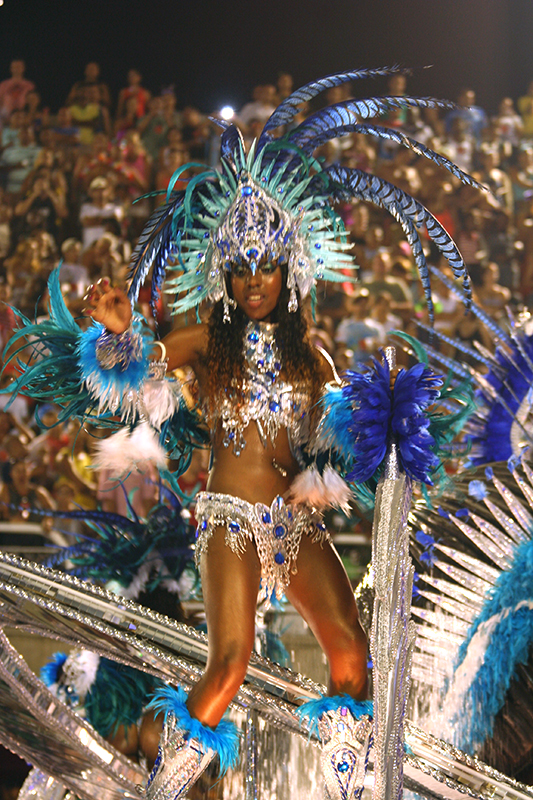 The evening’s parade kicked off at 9.00pm when Uniao da Ilha flooded the stadium music system with their samba song that was repeated again and again until their show finished. We were positioned about two thirds of the way down the runway and they took nearly half an hour before the dancers leading the school reached us. Thereafter, we were immersed in the colour of the forest of costumes that slowly moved passed. The crowd did not hold back, joining in the song, dancing and clapping and, if it was the samba school that they supported, shouting encouragement and praise. It is impossible not to get entirely submerged in the emotion of the occasion, singing along to Samba and dancing to the beat of drums that shake the concrete foundations. The organization and sheer effort that goes into each parade is considerable: the costumes are unique, flamboyant, complicated and never used again. The floats are intricate, cleverly designed to tell a story, full of colourfully dressed people and can reach up to 30 metres high. It is a spectacle like no other and it is wonderful to feel a part of it and enjoy such a special occasion.
The evening’s parade kicked off at 9.00pm when Uniao da Ilha flooded the stadium music system with their samba song that was repeated again and again until their show finished. We were positioned about two thirds of the way down the runway and they took nearly half an hour before the dancers leading the school reached us. Thereafter, we were immersed in the colour of the forest of costumes that slowly moved passed. The crowd did not hold back, joining in the song, dancing and clapping and, if it was the samba school that they supported, shouting encouragement and praise. It is impossible not to get entirely submerged in the emotion of the occasion, singing along to Samba and dancing to the beat of drums that shake the concrete foundations. The organization and sheer effort that goes into each parade is considerable: the costumes are unique, flamboyant, complicated and never used again. The floats are intricate, cleverly designed to tell a story, full of colourfully dressed people and can reach up to 30 metres high. It is a spectacle like no other and it is wonderful to feel a part of it and enjoy such a special occasion.
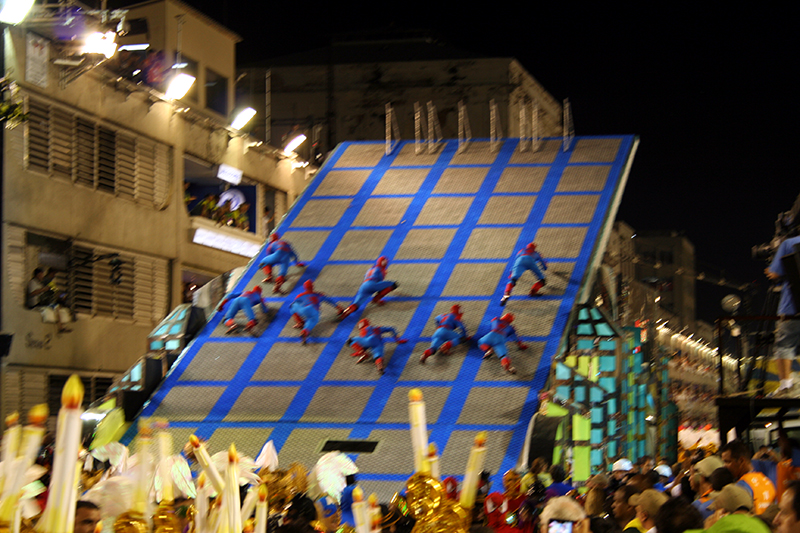 It goes on all night with only a break of a few minutes between schools and, as we did not feel tired, we stayed until the bitter end, enjoying every moment. The best display was from a school called Unidos a Tijuca whose theme was ‘secrets’. Their display was lead off by an enormous black box from which conjurers and magicians emerged to perform illusions and tricks that got the crowd really buzzing. As a giant flag passed over dancers, they changed costume mid step. How did they manage that? They also had Batmen skiing down a float capes flowing, Spidermen climbing up, Michael Jackson back from the dead, characters from fairy tales, ghostbusters, people appearing and disappearing and Merlin. Great entertainment. We later learnt that they won the competition but by only 0.7 of a point!
It goes on all night with only a break of a few minutes between schools and, as we did not feel tired, we stayed until the bitter end, enjoying every moment. The best display was from a school called Unidos a Tijuca whose theme was ‘secrets’. Their display was lead off by an enormous black box from which conjurers and magicians emerged to perform illusions and tricks that got the crowd really buzzing. As a giant flag passed over dancers, they changed costume mid step. How did they manage that? They also had Batmen skiing down a float capes flowing, Spidermen climbing up, Michael Jackson back from the dead, characters from fairy tales, ghostbusters, people appearing and disappearing and Merlin. Great entertainment. We later learnt that they won the competition but by only 0.7 of a point!
The only disappointment was the entire organization surrounding the event. Having paid a fortune for the tickets and another one to have them delivered to our hotel so that I would not spend hours standing in a queue, they did not turn up. I then spent the best part of a day chasing them with emails and phone calls that were not answered. When they did finally arrive following a small verbal volcanic eruption, they were not for the area I had booked and paid. After further unanswered communications, I gave up not wanting to spend all my time in Rio messing about with tickets. Then, when the parade finished at 5.40am there were insufficient buses to get everyone home (‘we were not expecting so many people’!). Two hours later, during which time we could have easily walked home, we arrived back at our hotel. This dire standard of organization was repeated with other tours. Given that the carnival has happened every year since time began, I wonder how they will cope with the World Cup in 2014 and the Olympics in 2016! It’s a disaster waiting to happen.
 The city tour we booked was also dreadful. The guide, a woman who looked as if she sucked lemons for a hobby, arrived 30 minutes early while we were having breakfast and told us that, if we did not come straight away, she would leave without us. Unbreakfasted, we then spent nearly two hours on a bus collecting others from different hotels during which she helpfully told us we were passing the University and the Naval base. When we arrived at Sugar Loaf, we were told that we had fifteen minutes for a quick look around on our own (she disappeared without pointing out any sites) because she had a schedule to meet and another tour in the afternoon. I told her that we would be leaving the tour because a) we would not be finished in fifteen minutes and b) that she was the worst guide we had had in South America. She said that it wasn’t her fault.
The city tour we booked was also dreadful. The guide, a woman who looked as if she sucked lemons for a hobby, arrived 30 minutes early while we were having breakfast and told us that, if we did not come straight away, she would leave without us. Unbreakfasted, we then spent nearly two hours on a bus collecting others from different hotels during which she helpfully told us we were passing the University and the Naval base. When we arrived at Sugar Loaf, we were told that we had fifteen minutes for a quick look around on our own (she disappeared without pointing out any sites) because she had a schedule to meet and another tour in the afternoon. I told her that we would be leaving the tour because a) we would not be finished in fifteen minutes and b) that she was the worst guide we had had in South America. She said that it wasn’t her fault.
At least we were able to relax and enjoy the 360 degree spectacular views of the city, the harbour and the island satellites dotted around the bay. We missed seeing the cathedral close up but we got a good view of it from above: it is not unlike Liverpool’s Catholic Cathedral that resembles an Indian teepee. As we were enjoying the views, a guide with a small group came alongside and we learnt a hundred times more from him in 5 minutes than from our guide in 2 hours.
 We took ourselves up Corcovado hill on top of which sits the statue of Christ the Redeemer. It’s another fantastic vantage point that shows the city from a different angle although it also reveals the extent of the pollution that hangs in the air and explains why I wake up feeling groggy (no, it cannot be the alcohol). The statue itself is magnificent: its simplicity is the trump card of being recognizable from miles all around as it brings peace and protection to all below.
We took ourselves up Corcovado hill on top of which sits the statue of Christ the Redeemer. It’s another fantastic vantage point that shows the city from a different angle although it also reveals the extent of the pollution that hangs in the air and explains why I wake up feeling groggy (no, it cannot be the alcohol). The statue itself is magnificent: its simplicity is the trump card of being recognizable from miles all around as it brings peace and protection to all below.
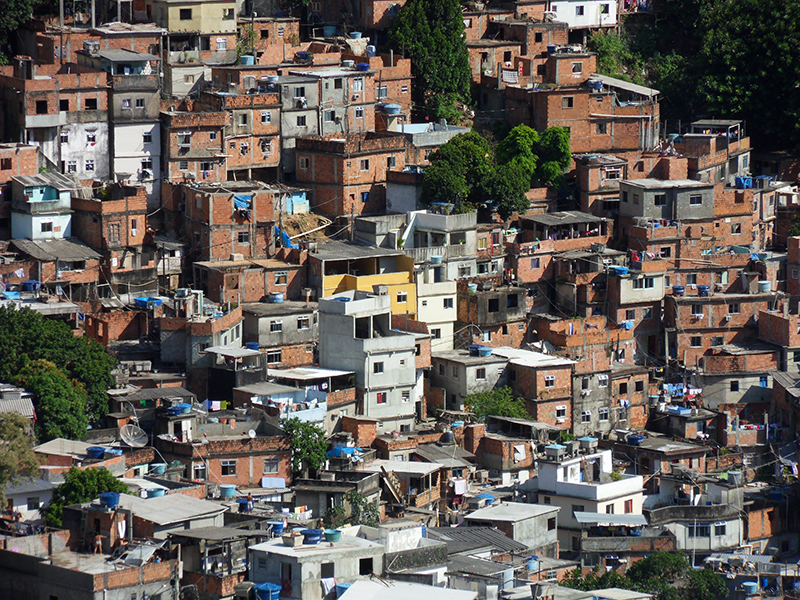 The most eye opening trip we did was to two local favelas. These are Rio’s ghettos and there are hundreds of them of differing sizes scattered all around the city. They have a reputation for being violent, lawless and poverty stricken and tourists are warned not to go near them – so we could not resist. First of all, the favelas are driven by a Brazilian law that says if someone occupies a piece of land for five years without challenge, its theirs and they can receive title deeds. The minimum wage in Brazil is R500 per month, in ‘Reals’ in local currency (US$123) and the people who are driven here cannot afford housing (which is not provided by the state anyway). They are the road sweepers, hotel maids and other low paid workers like construction workers. So shelters made from ‘left overs’ from building sites spring up daily and the local police either do not have the manpower or the will to do anything to prevent the communities from being established.
The most eye opening trip we did was to two local favelas. These are Rio’s ghettos and there are hundreds of them of differing sizes scattered all around the city. They have a reputation for being violent, lawless and poverty stricken and tourists are warned not to go near them – so we could not resist. First of all, the favelas are driven by a Brazilian law that says if someone occupies a piece of land for five years without challenge, its theirs and they can receive title deeds. The minimum wage in Brazil is R500 per month, in ‘Reals’ in local currency (US$123) and the people who are driven here cannot afford housing (which is not provided by the state anyway). They are the road sweepers, hotel maids and other low paid workers like construction workers. So shelters made from ‘left overs’ from building sites spring up daily and the local police either do not have the manpower or the will to do anything to prevent the communities from being established.
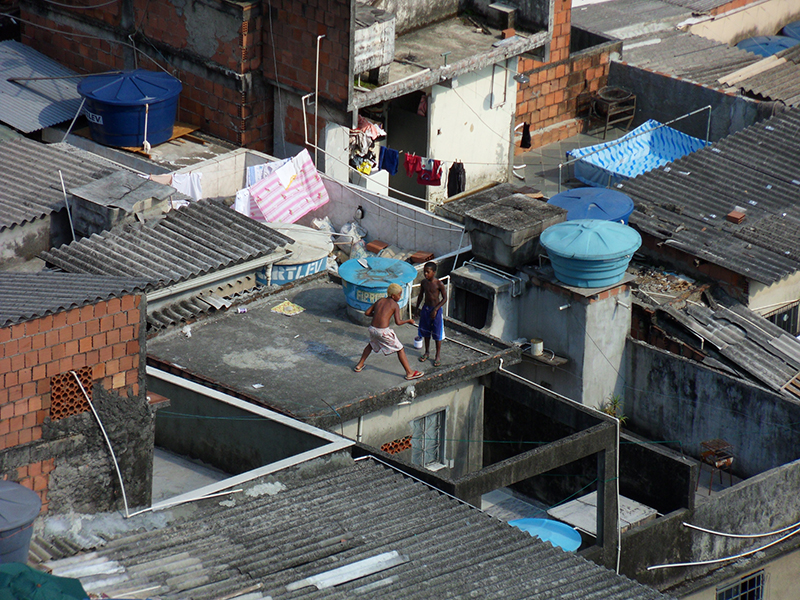 In fact, the favelas are a no-go area for the police, being run by drug dealers who enforce strict rules and hand out summary justice. The main rules seem to be, within the favela, no stealing, no personal crimes and don’t do anything that will bring the police into the area. Anyone who breaks the rules gets shot. It is much the same code and way of life that the IRA forced upon communities in Northern Ireland. As tourists, therefore, we were relatively safe and probably much safer than in certain other, touristy, areas of Rio.
In fact, the favelas are a no-go area for the police, being run by drug dealers who enforce strict rules and hand out summary justice. The main rules seem to be, within the favela, no stealing, no personal crimes and don’t do anything that will bring the police into the area. Anyone who breaks the rules gets shot. It is much the same code and way of life that the IRA forced upon communities in Northern Ireland. As tourists, therefore, we were relatively safe and probably much safer than in certain other, touristy, areas of Rio.
Every hillside above the city has a favela cut into the rainforest and they are often situated right next to a rich neighbourhood. Next to the Sheraton Hotel, next to the American Community School, next to the most expensive property in the area. They have the best views in the City!
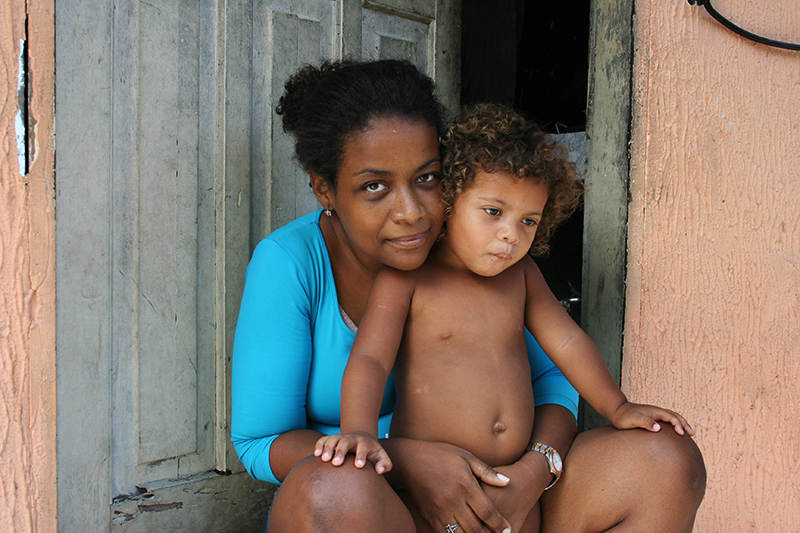 We visited two favelas, the first called Vila Canoas, had a community of 20,000 people, and the second called Rocinha had a community of 100,000 all living on top of one another. The narrow winding streets and alleyways were just about wide enough for one person at a time and the buildings seemed to imprison us as the walls rose from below ground level until they appeared to meet way above us. But there was electricity, some broadband, sewage (after a fashion). Buses ran to and from the communities, but not signed for the favela, there were shops and restaurants and some even had their own schools, health centres, newspapers and TV station. It’s all pretty civilized in many ways.
We visited two favelas, the first called Vila Canoas, had a community of 20,000 people, and the second called Rocinha had a community of 100,000 all living on top of one another. The narrow winding streets and alleyways were just about wide enough for one person at a time and the buildings seemed to imprison us as the walls rose from below ground level until they appeared to meet way above us. But there was electricity, some broadband, sewage (after a fashion). Buses ran to and from the communities, but not signed for the favela, there were shops and restaurants and some even had their own schools, health centres, newspapers and TV station. It’s all pretty civilized in many ways.
As for the drug gangs, all openly carrying guns, it is said that the members are all aged in their mid-twenties or under. They do not have long lives because they end up dead either by consuming their own stock or by a bullet to the head. Other gangs, or occasionally, the police come after them. They use a network of motorbikes without number plates to move stuff around and employ kids to keep look out on most corners. We are strictly forbidden from trying to photograph any of them.
As for the inhabitants, on the one hand they have to submit to the rule of the dealers but, on the other, there is less crime than in other parts of the city. They seem quite content: front doors are left open, people are friendly and welcoming and the atmosphere seemed very relaxed.
Households had much of the material goods that we have seen in ‘normal’ areas: TVs, fridges, radios, all manner of white and brown goods. These can be bought on credit terms without the need for credit checking that we are subjected to back home. A TV will cost 15×100, that is 15 payments of 100 Brazilian Reals. A fridge might be 10×35. The purchaser is trusted to pay on time and in full or suffer a visit from the enforcer from the drug gang.
It was a fascinating experience, one that I confess I do not really understand. But it seems to work and the inhabitants do not appear to live in fear or be distressed. I feel that there must be a more sinister side somewhere beneath the surface that we have not been allowed to see and I would not be surprised if our visit turns out to be something of a PR exercise. All I can say is that we saw how the poorest live and were not threatened or mugged.
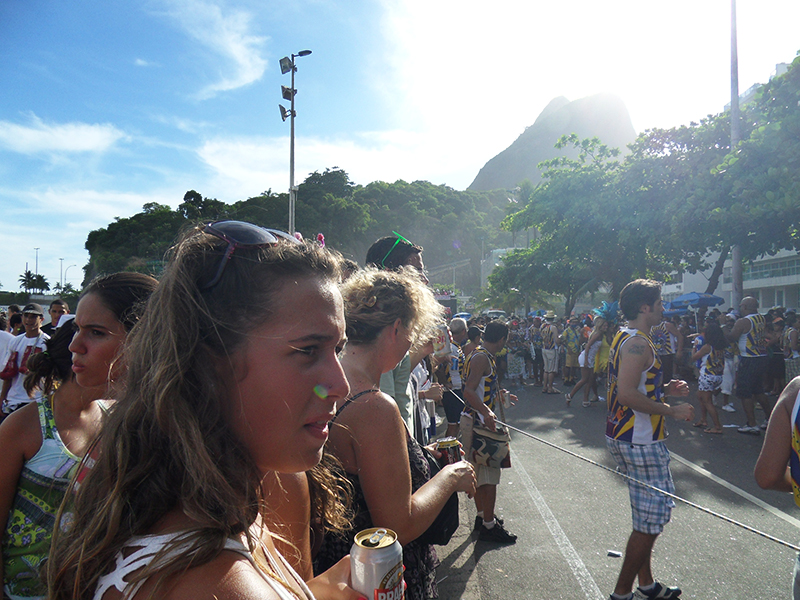 Anyway, it is still party time in Rio! Every day there was a street party and parade called a ‘Bloco’ along the beach in front of our hotel. It is pretty chaotic and disorganized but, nonetheless, draws a large crowd of around 3,000 people, mostly youngsters, all dressed up. The police close the road as people mill about in various amounts of fancy dress, greeting friends, making new acquaintances, hailing anyone and drinking. It seems a good excuse to drink, mostly beer but also various other potent home brews sold by vendors who magic cans from inside a polystyrene box. The party continues until everyone has got fed up, fallen down drunk or gone to another get-together elsewhere. It’s all good natured and boisterous and a chance for those who cannot afford the set piece parade tickets to have some carnival fun.
Anyway, it is still party time in Rio! Every day there was a street party and parade called a ‘Bloco’ along the beach in front of our hotel. It is pretty chaotic and disorganized but, nonetheless, draws a large crowd of around 3,000 people, mostly youngsters, all dressed up. The police close the road as people mill about in various amounts of fancy dress, greeting friends, making new acquaintances, hailing anyone and drinking. It seems a good excuse to drink, mostly beer but also various other potent home brews sold by vendors who magic cans from inside a polystyrene box. The party continues until everyone has got fed up, fallen down drunk or gone to another get-together elsewhere. It’s all good natured and boisterous and a chance for those who cannot afford the set piece parade tickets to have some carnival fun.
 The mess that gets left behind is enormous but, by daylight, everything has been cleared up. Even the sand has been swept back onto the beach. Kids collect the empty cans as fast as they are able as they get paid by the kilo. They have to collect 75 cans to make a kilo in weight and they can earn 30 Reals (US$15) per kilo (though during carnival the price drops by 30%). Others collect plastics and paper to sell for recycling and the corporation dustmen take the remainder.
The mess that gets left behind is enormous but, by daylight, everything has been cleared up. Even the sand has been swept back onto the beach. Kids collect the empty cans as fast as they are able as they get paid by the kilo. They have to collect 75 cans to make a kilo in weight and they can earn 30 Reals (US$15) per kilo (though during carnival the price drops by 30%). Others collect plastics and paper to sell for recycling and the corporation dustmen take the remainder.
We had a fabulous time in Rio despite various agencies doing their best to discourage us by the useless organization. It is a city that is vibrant with colour and life but also enjoys the most magnificent setting on the continent.







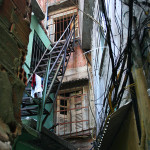












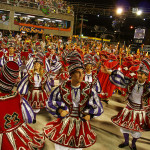
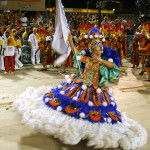
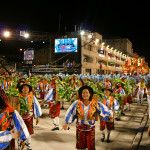
No comments yet.